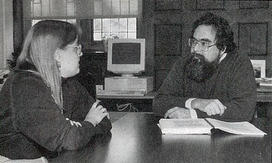The following story was originally published in the April 2, 1997, issue of PAW.
Tolerating them, Noel Coward once said, was like interrupting love-making to answer the front door. Academicians use them as badges of erudition and scholarly one-upmanship. Informed readers regard them as a learned mosaic that reflects the intellectual artistry of an author. Regardless of its relative merit, the footnote is a little-understood and underappreciated fixture in the history of humanistic scholarship. However, Dodge Professor of History Anthony T. Grafton is doing his part to shore up the footnote’s sagging status.
Its worth was called into question in August 1996, when The New York Times pronounced its demise. Growing numbers of scholars and popular historians, the article said, were eschewing footnotes as “a parade of attribution, exegesis and qualification which some readers might find irritating or superfluous,” as British historian F.M.L. Thompson once wrote. Moreover, editors at university presses, having inherited “mid-list” titles from trade-book publishers, were dumping footnotes overboard to appeal to a wider (more lucrative) readership. Other stories in the press soon followed. Apparently, the sky of scholarship was falling.
Grafton doesn’t think so. He argues, in an article appearing in the winter issue of The Wilson Quarterly (without the use of footnotes; such is the license of the personal essay), that reports of the footnote’s death have been greatly exaggerated. As long as university presses fulfill their time-honored function of publishing learned books for a learned reading public, there will always be, he jokes, a cure for insomnia.

“I must make the confession of a pedant: I have just always found the footnote fascinating,” says Grafton, a 1995-96 recipient of a Howard T. Behrman Award for Distinguished Achievement in the Humanities. “On the one hand, it was something I was trained to do very early on; on the other, I never heard anything about where the footnoting came from — unlike the sciences, where you learn who invented them and what kind of struggle it took to establish them.”
Systemic documentation-the footnote being one form-has been with us for a long time. Exactly how long wasn’t adequately understood until Grafton arrived on the scene.
In the ancient world, scholars and historians skirted the braggadocio of history’s players to analyze documents independently. Early historians of Judaism and Christianity also relied on primary sources to set the record straight. And the reference books of late antiquity and the Middle Ages, diligently produced by Roman lawyers and Catholic theologians, also demonstrate an extensive use of a system of documentation.
According to Grafton, the modern footnote took its form in the later part of the 17th century. At a time when many staples of knowledge were under question-the Bible, nature, God-Descartes was challenging the certainty or usefulness of historical knowledge with his philosophical ruminations. Scholars countered, arguing that an account of the past, grounded in careful examination of primary sources, could be validated. A century later, academics such as historian Edward Gibbon were creating texts with considerable literary elan, studded with footnotes of impressive erudition. However, Leopold von Ranke, a 19th-century professor from Berlin, is widely considered the founder of the modern documented historiography. “He transformed history, in theory, by insisting that every narrative about the past should rest on a systemic analysis of the sources,” says Grafton. “But his practices were far less rigorous than his theoretical professions. For example, he would add the footnotes after writing the text.”
This burgeoning world of text and footnote was no problem for 18th-century readers, Grafton points out. They were a small, highly educated group accustomed to this style of point/counterpoint-much like kids bopping around on the Internet today. Democracy and modernity, although shedding light into many dark corners of illiteracy around the world, have nonetheless produced less discerning readers. “So,” says Grafton, “today’s reading public-huge, amorphous and sharing very little in common-regards the footnote as an obstacle because it interrupts the reading of the text.”
But times change, and Grafton does not expect any dramatic proliferation of footnotes. Different books, he points out, demand different types of documentation. He sees nothing wrong with extensive bibliographies or the use of endnotes, either at the end of chapters or of the book itself. Undoubtedly, footnotes have their limitations, yet they reveal the tacks taken in pursuit of the truth.
And that’s fine by Grafton. “Something is never too heavily footnoted for me,” he says. “I don’t mind a page that is one-third footnotes or a book that is two-fifths endnotes. I’ll probably read that, end to end, with great pleasure.”











1 Response
Norman Ravitch *62
8 Years AgoTruth is so elusive that...
Truth is so elusive that footnotes are needed — to show that what one has concluded is based on someone else's delusions and not on one's own. Think of the Bible, it can be considered the footnotes of God.